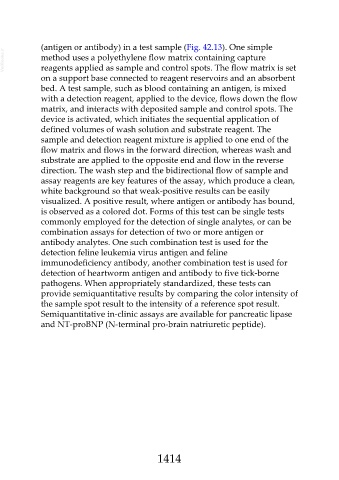Page 1414 - Veterinary Immunology, 10th Edition
P. 1414
(antigen or antibody) in a test sample (Fig. 42.13). One simple
VetBooks.ir method uses a polyethylene flow matrix containing capture
reagents applied as sample and control spots. The flow matrix is set
on a support base connected to reagent reservoirs and an absorbent
bed. A test sample, such as blood containing an antigen, is mixed
with a detection reagent, applied to the device, flows down the flow
matrix, and interacts with deposited sample and control spots. The
device is activated, which initiates the sequential application of
defined volumes of wash solution and substrate reagent. The
sample and detection reagent mixture is applied to one end of the
flow matrix and flows in the forward direction, whereas wash and
substrate are applied to the opposite end and flow in the reverse
direction. The wash step and the bidirectional flow of sample and
assay reagents are key features of the assay, which produce a clean,
white background so that weak-positive results can be easily
visualized. A positive result, where antigen or antibody has bound,
is observed as a colored dot. Forms of this test can be single tests
commonly employed for the detection of single analytes, or can be
combination assays for detection of two or more antigen or
antibody analytes. One such combination test is used for the
detection feline leukemia virus antigen and feline
immunodeficiency antibody, another combination test is used for
detection of heartworm antigen and antibody to five tick-borne
pathogens. When appropriately standardized, these tests can
provide semiquantitative results by comparing the color intensity of
the sample spot result to the intensity of a reference spot result.
Semiquantitative in-clinic assays are available for pancreatic lipase
and NT-proBNP (N-terminal pro-brain natriuretic peptide).
1414

